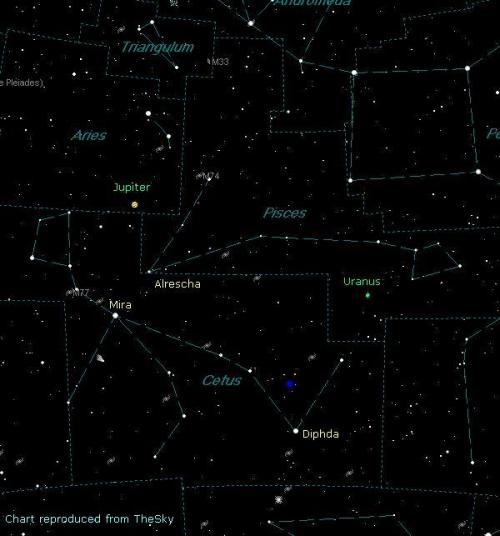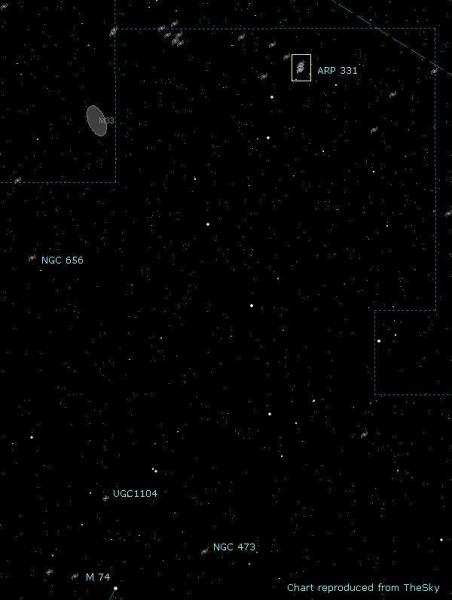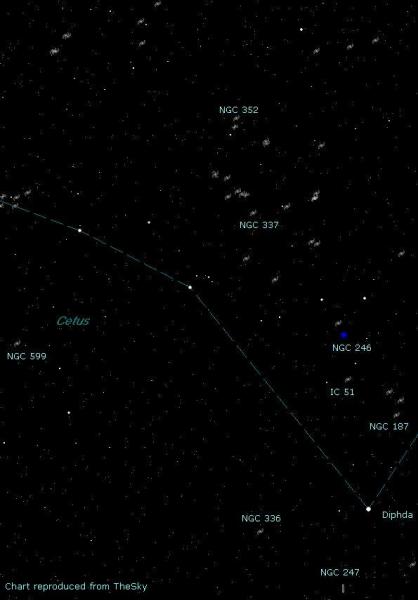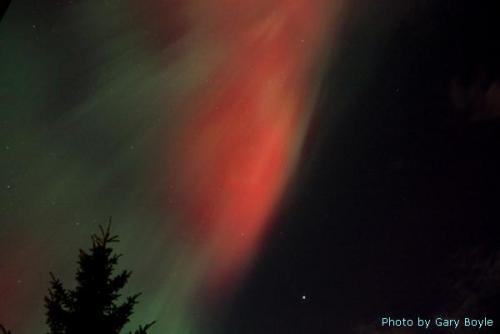Of Fish and Whales
As we open the second to last month of 2011, we set our sights on a couple of watery creatures namely Pisces and Cetus. On the first of the month, they are located on the meridian at about 10 p.m. local time and well placed for galaxy hunting. Our two feature constellations reside in an area called “The Water” and is also home to other such starry patterns as Eridanus and Aquarius.
First, we have Pisces the Fish which mythology depicts as two fishes connected by a ribbon. To escape the wraths of the sea monster Typhon, the goddess Aphrodite and her son Eros take on the form of fish and the ribbon help secure them as not to be separated from each other. Pisces is situated southeast of the winged horse Pegasus. Pisces also marks that area where the Sun crosses the celestial equator into the northern hemisphere during the spring equinox.
Pisces is not a very bright constellation. Its members of the asterism all list in the magnitude four range. Derived from the Arabic word meaning ‘the cord’, Alrescha is regarded as the alpha star and is the point that connects the two imaginary ribbons. With a value of magnitude 3.94, Alrescha consists of a very close binary star system residing 139 light-years from us. Astronomers estimate the two may only orbit once every 720 years. If this is true, they will attain their closest approach in the year 2060. Each of these stars might possess a spectroscopic binary star, extremely close to its parent sun.
The total dimension of sky is 889 square degrees and stands as the fourteenth largest in area. The one and only Messier object calling Pisces home is M74. This fine example of a face-on galaxy is complicated by the fact is lies 35 million light-years away and has a low surface brightness. At magnitude 9.4, it could be a bit of a challenge locating it. The only plus is it measures 10 by 9 arc minutes keeping in mind the Moon appears 30 arc minutes wide.

Located at the northern portion of the constellation is a lovely string of five galaxies known as ARP 331. The five are catalogued from north to south as NGC 379, 380, 383, 385 and 384. They range from magnitude 11.9 to 13.0 with NGC 379 being the only elongated member of the group. The rest are round and featureless. ARP 331 is located about six degrees west of the fantastic galaxy M33 in Triangulum and takes up a little more than ten arc minutes of sky. The planet Uranus is currently in the southern section of Pisces. Its bluish-green fuzzy appearance shines at magnitude 5.8 and is 2.9 billion kilometres away. Even at the speed of light, a pulse would take two hours and forty minutes to reach us.
Situated below the Fishes, we find Cetus the Whale or Sea Monster that ranks 4th in area and with 1,231 square degrees of sky. In mythology, The Monster was about to devour Andromeda but was foiled in its bid by Perseus. The bright star Mira was the first non-supernova variable to be discovered. At a distance of 420 light-years from us, this giant red star’s brightness varies from magnitude 2.0 all the way down to a dim 10.1. Its cycle can range from 80 to 1,000 days. Some 6,000 variable stars have been placed under its own category called Mira Variables.

NGC 246 is an interesting planetary nebula. Also known as the Skull Nebula and catalogued as Caldwell 56, the outcast shell of old star material takes on a deep bluish hue which is very striking in photos. NGC 246 only measures 3.8 arc minutes wide and glows at magnitude 8.0 with a 12th magnitude white dwarf central star. Distance to the Skull is somewhere between 1,800 and 2,400 light-years. To find NGC 246, first, locate the second magnitude star call Diphda and then nudge your scope up a little more than six degrees.
Next, we will look at the spiral galaxy M77 east of the star Mira. This is one of the largest galaxy found on the Messier list of stellar objects. It appears to be 120,000 wide with other sources calculating an even higher value. M77 is located 60 million light-years from us and is classified as a Seyfert Galaxy. This monster of a galaxy could hold as much as a trillion solar masses.
NGC 337 is an elongated galaxy that sports a 15th magnitude supernova in it. The galaxy itself is a magnitude 11.8 smudge that measures only 2.8 arc minutes wide. NGC 337 is estimated to reside some 66 million light-years away and can be found a tad more than 5 degrees northeast of the earlier mentioned planetary nebula NGC 246.

Comet P/2006 T1 Levy is well placed in the constellation Lacerta. It is presently magnitude 10.7 and brightening. This is David Levy’s 22nd comet discovery and this one was found visually from his observatory near Tucson AZ. This periodic comet has a return orbit of 5.24 years. Our interstellar visitor will be around for the next few months and is expected to peak in brightness during the last week of January. The other icy mountain namely Comet C/2009 P1 Garradd is now situated in Hercules and is glowing nicely at magnitude 7.8.
Two minor meteor showers are slated for this month. First, we have the S Taurids that will peak on the 5th with a rate of only 10 meteors seen per hour. Twelve nights later the Leonids will only produce 20 or so meteors per hour. This is a far cry from the great storm from a decade ago where I was seeing rates of 35 per minute or 2,100 per hour. Hopefully, these numbers will increase over the next few years.
The planet Jupiter has just passed opposition and is out all night. With our two worlds still relatively close together (594 million kilometres), this is prime time to image the planet. The red planet – Mars is back in the morning skies. It drifts about the star Regulus in the constellation Leo on the 7th
Brilliant Venus and moderately bright Mercury (our inner planets) rise as a pair low in the west after sunset for the first half of November. From the 15th Venus continues to rise as Mercury starts to pull a u-turn back down to the Sun. Follow and photograph this tag team on clear nights.
For most provinces in Canada, the first weekend of November is time to adjust our clocks one hour back to good ole standard time. Remember to subtract that hour when converting to Universal Time. November’s full moon is called the Beaver Moon and occurs on the 10th at 3:16 EST. New moon (lunation 1100) occurs on the 25th.
And finally, keep monitoring bulletins and your skies for aurora activity. On the night of October 24th, I was fortunate to enjoy and take some photos of a grand display. The last great storm seen from Canada was back in 2004. Solarmax is predicted for 2013 so our chances of seeing Northern Lights are getting better.
Until next month, clear skies everyone.

